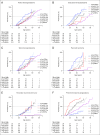Genotype-specific neoplastic risk profiles in patients with VHL disease
- PMID: 40202835
- PMCID: PMC12060576
- DOI: 10.1530/ERC-24-0260
Genotype-specific neoplastic risk profiles in patients with VHL disease
Abstract
Hereditary tumor predisposition syndromes pose a challenge for early detection and timely treatment of tumors. In von Hippel-Lindau disease, desirable personalized surveillance programs are lacking due to insufficient data on genotype-specific risk profiles of individual mutations. To describe neoplastic risk profiles for carriers of pathogenic and likely pathogenic VHL germline mutations, our observational study recruited 1,350 participants from 40 centers worldwide. 432 different VHL germline mutations were observed, with p.Asn78Ser, p.Arg161Ter, p.Arg161Gln, p.Arg167Gln, p.Arg167Trp and p.Tyr98His being the six most frequent, occurring in a total of 493 carriers (36.5%) and in ≥30 patients each. Age-related penetrance risks for retinal hemangioblastoma, central nervous system hemangioblastoma, renal cell carcinoma, pancreatic neuroendocrine tumors and pheochromocytoma/paraganglioma in carriers of the most frequent VHL mutations were assessed. In addition, the number of organs affected, the frequency of surgery and the outcome are reported. Pairwise comparisons of the age-dependent tumor penetrance of these six mutations showed that 47 out of 90 pairs were significantly different. The most significant associations were found in p.Tyr98His (n = 19), followed by p.Arg161Ter (n = 10). All pairwise comparisons of mutations affecting different codons showed at least one significant (P < 0.05) difference, except for p.Asn78Ser vs p.Arg161Ter. Thus, tumor risk varied by VHL mutation type and location, but did not differ between the truncating mutation p.Arg161Ter and the missense mutation p.Asn78Ser. Our study demonstrates the importance of mutation-specific phenotype prediction. With appropriate validation, the data have important implications for risk assessment and decision making in tumor prevention for carriers of the respective VHL mutations.
Keywords: genotype-phenotype; personalized preventive medicine; tumor risk profiles; von Hippel–Lindau disease.
Conflict of interest statement
Joanne Ngeow is an Associate Editor of
Figures
References
-
- Benjamini Y & Hochberg Y. 1995. Controlling the false discovery rate – a practical and powerful approach to multiple testing. J Roy Stat Soc B Stat Methodol 57 289–300. (10.1111/j.2517-6161.1995.tb02031.x) - DOI
Publication types
MeSH terms
Substances
LinkOut - more resources
Full Text Sources
Medical


